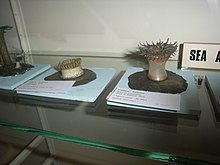
Anthozoa is a class of marine invertebrates which includes the sea anemones, stony corals and soft corals. Adult anthozoans are almost all attached to the seabed, while their larvae can disperse as part of the plankton. The basic unit of the adult is the polyp; this consists of a cylindrical column topped by a disc with a central mouth surrounded by tentacles. Sea anemones are mostly solitary, but the majority of corals are colonial, being formed by the budding of new polyps from an original, founding individual. Colonies are strengthened by calcium carbonate and other materials and take various massive, plate-like, bushy or leafy forms.

Heteractis magnifica, also known by the common names magnificent sea anemone or Ritteri anemone, is a species of sea anemone belonging to the Stichodactylidae family native to the Indo-Pacific area.

The aggregating anemone, or clonal anemone, is the most abundant species of sea anemone found on rocky, tide swept shores along the Pacific coast of North America. This cnidarian hosts endosymbiotic algae called zooxanthellae that contribute substantially to primary productivity in the intertidal zone. The aggregating anemone has become a model organism for the study of temperate cnidarian-algal symbioses.

The sebae anemone, also known as leathery sea anemone, long tentacle anemone, or purple tip anemone, is a species of sea anemone belonging to the family Stichodactylidae and native to the Indo-Pacific area.

Bubble-tip anemone is a species of sea anemone in the family Actiniidae. Like several anemone species, E. quadricolor can support several anemonefish species, and displays two growth types based on where they live in the water column, one of which gives it the common name, due to the bulbous tips on its tentacles.
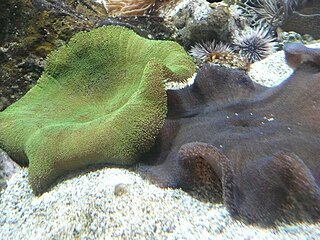
Stichodactyla haddoni, commonly known as Haddon's sea anemone, is a species of sea anemone belonging to the family Stichodactylidae. It is found in the Indo-Pacific area.

Aiptasia is a genus of a symbiotic cnidarian belonging to the class Anthozoa. Aiptasia is a widely distributed genus of temperate and tropical sea anemones of benthic lifestyle typically found living on mangrove roots and hard substrates. These anemones, as well as many other cnidarian species, often contain symbiotic dinoflagellate unicellular algae of the genus Symbiodinium living inside nutritive cells. The symbionts provide food mainly in the form of lipids and sugars produced from photosynthesis to the host while the hosts provides inorganic nutrients and a constant and protective environment to the algae. Species of Aiptasia are relatively weedy anemones able to withstand a relatively wide range of salinities and other water quality conditions. In the case of A. pallida and A. pulchella, their hardiness coupled with their ability to reproduce very quickly and out-compete other species in culture gives these anemones the status of pest from the perspective of coral reef aquarium hobbyists. These very characteristics make them easy to grow in the laboratory and thus they are extensively used as model organisms for scientific study. In this respect, Aiptasia have contributed a significant amount of knowledge regarding cnidarian biology, especially human understanding of cnidarian-algal symbioses, a biological phenomenon crucial to the survival of corals and coral reef ecosystems. The dependence of coral reefs on the health of the symbiosis is dramatically illustrated by the devastating effects experienced by corals due to the loss of algal symbionts in response to environmental stress, a phenomenon known as coral bleaching.

Stichodactyla mertensii, commonly known as Mertens' carpet sea anemone, is a species of sea anemones in the family Stichodactylidae. It is regarded as the largest sea anemone with a diameter of over 1 m (3.3 ft), the next largest being Heteractis magnifica, which has longer tentacles. This species has an oral disc that can be described as more ovoid than circular that contours to the surrounding substrate and is attached to the substrate by adhesive verrucae, which are wart-like projections. Its blunt or pointed tentacles are uniformly shaped, and are only about 1–2 centimetres (0.39–0.79 in) long. It contains obligate symbiotic zooxanthellae, and is a host to around half the species of anemonefish and one damselfish, Dascyllus trimaculatus.

Sea anemones are a group of predatory marine invertebrates constituting the order Actiniaria. Because of their colourful appearance, they are named after the Anemone, a terrestrial flowering plant. Sea anemones are classified in the phylum Cnidaria, class Anthozoa, subclass Hexacorallia. As cnidarians, sea anemones are related to corals, jellyfish, tube-dwelling anemones, and Hydra. Unlike jellyfish, sea anemones do not have a medusa stage in their life cycle.
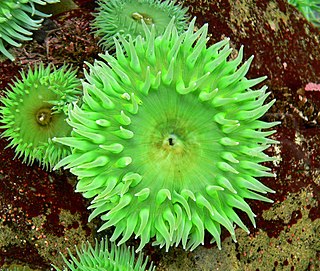
Anthopleura xanthogrammica, or the giant green anemone, is a species of intertidal sea anemone of the family Actiniidae.
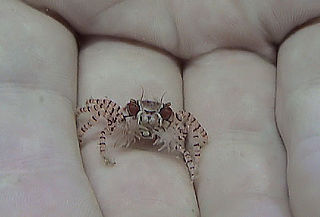
Triactis is a genus of sea anemone in the family Aliciidae. It is monotypic, having only one species – Triactis producta. This species is found in shallow waters in the Indo-Pacific where it lives on the seabed, rocks and corals. It derives much of its energy needs from the symbiotic algae it contains. It also forms a mutualistic relationship with small Lybia crabs.

Bartholomea annulata is a species of sea anemone in the family Aiptasiidae, commonly known as the ringed anemone or corkscrew anemone. It is one of the most common anemones found on reefs in the Caribbean Sea.

Cryptodendrum is a genus of sea anemones in the family Thalassianthidae. It is monotypic with a single species, Cryptodendrum adhaesivum, also commonly known as the adhesive anemone, pizza anemone, and nap-edged anemone. Like all symbiotic anemones it hosts zooxanthellae, symbiotic algae that help feed their host.

Lebrunia coralligens, commonly known as the hidden anemone, is a species of sea anemone in the family Aliciidae. It is found in shallow water in the Bahamas, the Caribbean, and Brazil. It lives in fissures in corals and rocks.
Aiptasia diaphana, commonly known as the yellow aiptasia or glasrose, is a species of sea anemone native to shallow waters in the temperate eastern Atlantic Ocean and the Mediterranean Sea. It has been introduced into the Red Sea.
Anthopleura thallia, commonly known as the glaucous pimplet, is a species of sea anemone in the family Actiniidae. It is found in shallow water in the northeastern Atlantic Ocean and the Mediterranean Sea.
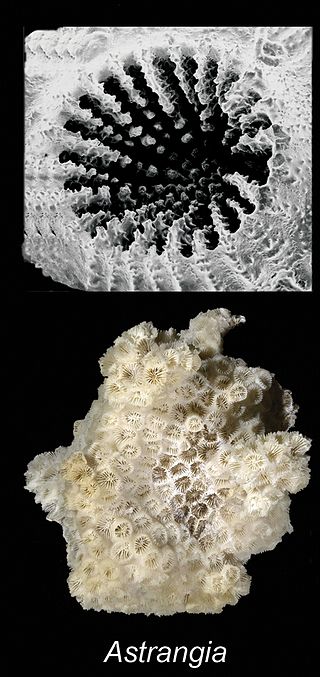
Astrangia poculata, the northern star coral or northern cup coral, is a species of non-reefbuilding stony coral in the family Rhizangiidae. It is native to shallow water in the western Atlantic Ocean and the Caribbean Sea. It is also found on the western coast of Africa. The International Union for Conservation of Nature lists this coral as being of "least concern". Astrangia poculata is an emerging model organism for corals because it harbors a facultative photosymbiosis, is a calcifying coral, and has a large geographic range. Research on this emerging model system is showcased annually by the Astrangia Research Working Group, collaboratively hosted by Roger Williams University, Boston University, and Southern Connecticut State University

Exaiptasia is a genus of sea anemone in the family Aiptasiidae, native to shallow waters in the temperate western Atlantic Ocean, the Caribbean Sea and the Gulf of Mexico. It is monotypic with a single species, Exaiptasia diaphana, and commonly known as the brown anemone, glass anemone, pale anemone, or simply as Aiptasia.

Gonactinia is a monotypic genus of sea anemones, and G. prolifera is the only species in the genus. It is sometimes called the storey anemone and is found on either side of the northern Atlantic Ocean.

Actinostella flosculifera, the collared sand anemone, is a species of sea anemone in the family Actiniidae. It is found semi-immersed in the sediment in shallow water in the tropical and subtropical Atlantic Ocean.
